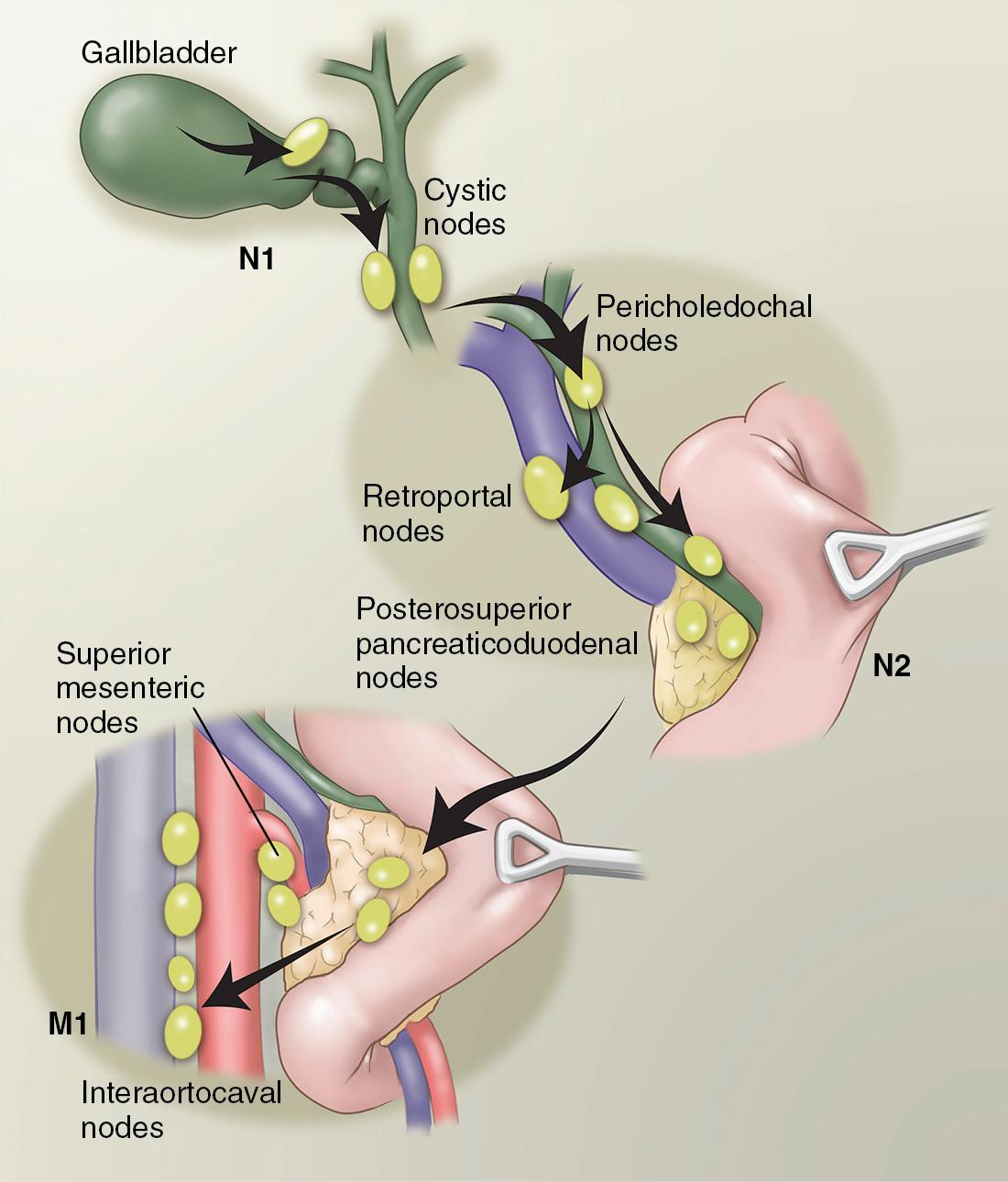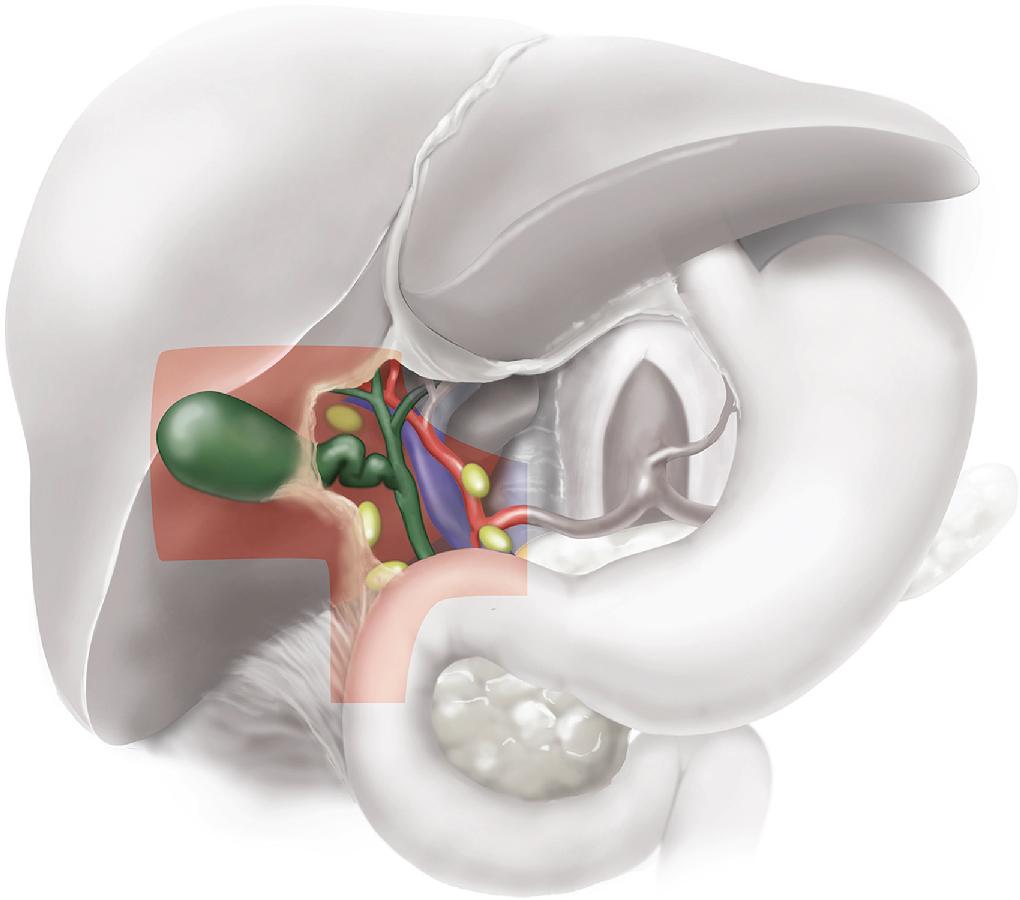Physical Address
304 North Cardinal St.
Dorchester Center, MA 02124
Although gallbladder cancer is rare, accounting for just 1.2% of all global cancers, it is the most common biliary tract malignancy, making up 80% to 95% of all biliary cancer diagnoses (see Chapter 49 ). Gallbladder cancer occurs most often in patients in their fifth decade of life and has a significant female predominance, with females affected 3 to 4 times as often as males. Although the underlying pathogenesis of gallbladder cancer is unknown, several risk factors have been identified that share a common characteristic of gallbladder inflammation, including gallstone disease, , gallbladder polyps, primary sclerosing cholangitis, and chronic infections with organisms such as Salmonella typhi , and Helicobacter bilis , in endemic areas (see Chapters 9E and 49 ).
Gallbladder cancer portends dismal prognosis as 70% to 90% of cancers are diagnosed at an advanced and thus noncurative stage. Median overall survival is 6 months, with a 5-year survival rate of just 5%. Systemic therapies have limited effectiveness, and surgical resection remains the only potentially curative therapy. Although surgery is the only potentially curative treatment option, survival following surgery is highly variable, ranging from 10% to 100% at 5 years depending on disease stage and extent of resection (see Chapters 9E and 49 ). In this chapter, we discuss the surgical management of gallbladder cancer, management of port site recurrences, and timing of re-resection for incidentally discovered gallbladder cancer following routine cholecystectomy.
More than half of gallbladder cancers are incidentally diagnosed during evaluation and treatment for presumed benign biliary disease , (see Chapters 12 , 34 , and 49 ). A diagnosis of malignancy is either made intraoperatively or, more commonly, postoperatively based on histopathologic examination of the cholecystectomy specimen.
In patients with incidentally diagnosed gallbladder cancer recognized intraoperatively during cholecystectomy (see Chapters 34 and 36 ), a frozen section biopsy should be performed to obtain pathologic confirmation of malignancy and to determine the extent of disease. If gallbladder cancer is confirmed, no further dissection is recommended and surgery should be aborted. Prior recommendations were for completion of a curative-intent resection based on surgeon comfort, but current National Comprehensive Cancer Network (NCCN) guidelines recommend cessation of the procedure, to obtain a proper staging workup, and referral of the patient to an experienced hepatobiliary center for further evaluation and definitive resection. The rationale for this strategy is that residual disease (a non-R0 resection) at the initial operation despite an R0 re-resection is associated with outcomes equivalent to stage IV gallbladder cancer. ,
When gallbladder cancer is incidentally diagnosed postoperatively on pathologic examination of the specimen, accurate confirmation of pathologic stage is of utmost importance in guiding further treatment strategies. Consideration should be given to having the specimen re-evaluated by a hepatobiliary pathology specialist to confirm pathologic staging.
Whether a diagnosis of gallbladder cancer is made intraoperatively with cessation of further dissection or incidentally, postoperatively following cholecystectomy, all patients should undergo an extent of disease staging workup consisting of dynamic contrast-enhanced imaging, either computed tomography (CT) or magnetic resonance imaging (MRI) of the abdomen and pelvis plus chest CT (with or without contrast) (see Chapters 13 and 16 ). The role of fluorodeoxyglucose positron emission tomography (FDG-PET) in incidentally found gallbladder cancer is not well defined (see Chapters 18 and 49 ). A report in 63 patients with incidentally found gallbladder cancer found that in only 13% of patients did acquisition of FDG-PET imaging change management due to identification of metastatic disease. Tumor markers including serum carcinoembryonic antigen (CEA) and/or cancer antigen (CA) 19-9 are also often obtained; however, although used as a prognostic biomarker, there are few data to suggest increased sensitivity or specificity compared with high-resolution imaging in the identification of metastatic disease. ,
Due to the high prevalence of metastatic disease and the lack of palliative surgical options in gallbladder cancer, a staging laparoscopy should be routinely performed , to identify occult liver, peritoneal, and lymph node metastases (see Chapters 24 and 49 ). Agarwal et al. reported that laparotomy can be avoided in 56% of patients with unresectable gallbladder cancer with the use of staging laparoscopy. Furthermore, Butte et al. demonstrated that although disseminated disease in incidentally found gallbladder cancer was an infrequent event, the likelihood of metastatic disease correlated with increasing T-stage, positive margin at initial cholecystectomy, and increasing tumor grade. Given the low risks of diagnostic laparoscopy and the benefits of avoiding a necessary laparotomy in the presence of disseminated disease, diagnostic laparoscopy should be routinely performed in all patients undergoing re-resection or primary resection of gallbladder cancer.
To perform a staging laparoscopy, entry into the abdomen is obtained with a Veress needle, an optical trocar, or an open cutdown method based on surgeon preference. A thorough inspection of both the visceral and parietal peritoneum in the abdomen and pelvis and the greater omentum is performed to identify metastatic lesions. If any suspicious areas are identified, frozen section biopsy is performed. A Kocher maneuver is performed reflecting the second portion of the duodenum and pancreatic head medially exposing the retropancreatic and aortocaval lymph nodes, which are inspected for abnormalities indicating N2 lymph node involvement ( Fig. 119A.1 ). If metastatic disease in the form of either peritoneal carcinomatosis, omental deposits, or N2 lymphadenopathy is identified, long-term outcomes following surgical resection are rare and thus the procedure is complete with no further resection. If no metastatic disease is identified, the operation proceeds according to operative intent, based on underlying cancer stage.

In T1a gallbladder cancer there is absence of muscular layer invasion as tumor cells are limited to the lamina propria, therefore simple cholecystectomy without lymph node dissection is appropriate (see Chapter 36 ). This can be performed using minimally invasive approaches (laparoscopically/robotically, see Chapters 127A and 127D ) or an open approach. Historically, an open approach was preferred in cancer operations; however, Feng et al. demonstrated that patients with Tis and T1a gallbladder cancer who underwent laparoscopic simple cholecystectomy had 100% 5-year survival, indicating favorable oncologic outcomes in laparoscopic resection. A simple cholecystectomy performed for gallbladder cancer is similar to a cholecystectomy performed for benign biliary disease; however, a few important differences must be considered. First, avoiding iatrogenic gallbladder perforation is imperative, as bile spillage is associated with a significantly higher risk of port site metastases (12.3% vs. 5.1%; P = .035) and local recurrences (22% vs. 11.7%; P = .034) with a nonsignificant trend toward a lower rate of peritoneal carcinomatosis (12.1% vs. 15.1%). Using a laparoscopic retrieval bag for specimen extraction can also decrease the risk of port site recurrences in general but especially if the gallbladder is perforated.
In T1b and T2 tumors, simple cholecystectomy fails to offer optimal oncologic benefit compared with radical resection, consisting of re-resection of the hepatic bed (partial hepatectomy of segments IVb/V) and hepatoduodenal lymphadenectomy ( Fig. 119A.2 ). In both T1b and T2 tumors, simple cholecystectomy is associated with 5-year survival rates of 20% to 40% compared with 70% to 90% following radical resection. Both incidence rates of residual disease within the hepatic parenchyma and lymph node metastatic disease are associated with advanced T stage. In T1b tumors, residual hepatic disease incidence of 10% and lymph node metastatic disease of 10% to 20% is associated with locoregional recurrence rates of 20% to 50%. Furthermore, in T2 tumors, hepatoduodenal lymph node metastatic disease has been reported in 30% to 60% of patients.

Become a Clinical Tree membership for Full access and enjoy Unlimited articles
If you are a member. Log in here